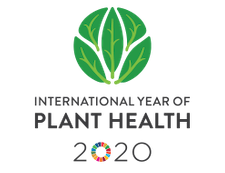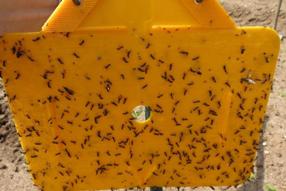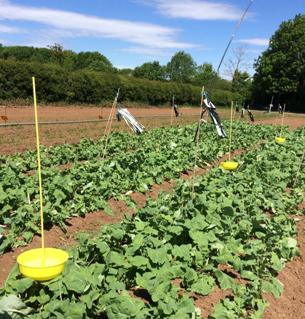Keeping a Watchful Eye on Pests
| The Food and Agriculture Organisation (FAO) of the United Nations have declared 2020 as the International Year of Plant Health (IYPH) and have called for organisations to raise global awareness on how protecting plant health can help end hunger, reduce poverty, protect the environment, and boost economic development. Much of the research in the School of Life Sciences is aimed at improving crop productivity and combating pests and diseases while conserving the environment in order to feed an increasing population. In this series of articles we highlight just some of the work related to IYPH2020. |

|
It is thought that, in the absence of control methods, crop losses due to pest insects might be in the order of 15-20% globally (Journal of Agricultural Science, Crop Losses to Pests, Feb 2006). However, pest numbers fluctuate considerably from place-to-place and year-to-year, as does the timing of pest infestations. To make best use of resources and minimise pesticide treatments it’s become increasingly important to know when certain pests are likely to infest individual crops. This may be through monitoring pest abundance on plants, trapping adult insects as they disperse, or by using previously-established relationships with weather conditions to predict when crops are at risk.
At Warwick we’ve been focusing on the pests that infest vegetable and salad crops and developing tools and sources of information that can help commercial growers target their pest management activities. This has included the development of forecasting tools for common pests such as cabbage root fly and carrot fly and investigating the use of different approaches to monitoring pest activity. In some instances, for pests whose life-cycles in the UK are less well-understood, we’ve been using trap captures ( left picture -water traps, right picture - sticky trap) to help us understand how best to manage them in the future.

Whether the means of managing the pest is with a pesticide or through another approach, information on the pest’s life-cycle is essential.

Technology is advancing all the time and some of it is likely to have positive spin-offs for pest management. In recent years we’ve been investigating how the large amounts of information displayed on web sites and through social media by ‘citizen scientists’ might be used to good effect. This is particularly appropriate for two species of moth (diamond-back moth, silver Y moth) that move large distances and often arrive ‘suddenly’ in the UK having migrated from continental Europe or as far away as North Africa. With both species, collation and presentation of information on regularly-updated web pages (diamond-back moth, silver Y moth) has provided timely warnings for growers.
Keeping track of pest insects can be time-consuming and costly and there are likely to be other advances in technology that assist with this. One such approach that we’ve already tested is the use of cameras to photograph traps at regular intervals and relay these images to a website where they can be viewed remotely. This system works well already for some pests, but for others where identification is more difficult, further developments may be required. A new H2020 thematic network 'SmartProtect', in which we are a partner, aims to identify new technologies for the management of pests and diseases of outdoor and protected vegetable crops and evaluate their usefulness in a range of situations. We are very interested to hear from companies who are developing/marketing such technologies.
A further aspect of our research is the dissemination of information to growers in formats that are accessible and immediately useful to them. The Agriculture and Horticulture Development Board (AHDB) and Syngenta UK are key partners in this activity, particularly with regard to production and dissemination of a weekly Pest Bulletin.
Further reading:
Phenology of the Diamondback Moth (Plutella xylostella) in the UK and Provision of Decision Support for Brassica Growers.
The Potential for Decision Support Tools to Improve the Management of Root-Feeding Fly Pests of Vegetables in Western Europe.
